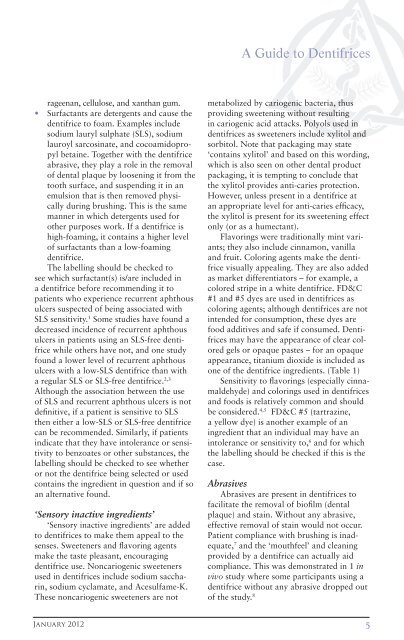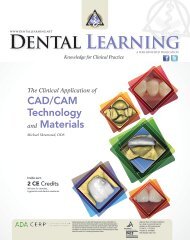Download PDF - Dental Learning
Download PDF - Dental Learning
Download PDF - Dental Learning
You also want an ePaper? Increase the reach of your titles
YUMPU automatically turns print PDFs into web optimized ePapers that Google loves.
ageenan, cellulose, and xanthan gum.<br />
• Surfactants are detergents and cause the<br />
dentifrice to foam. Examples include<br />
sodium lauryl sulphate (SLS), sodium<br />
lauroyl sarcosinate, and cocoamidopropyl<br />
betaine. Together with the dentifrice<br />
abrasive, they play a role in the removal<br />
of dental plaque by loosening it from the<br />
tooth surface, and suspending it in an<br />
emulsion that is then removed physically<br />
during brushing. This is the same<br />
manner in which detergents used for<br />
other purposes work. If a dentifrice is<br />
high-foaming, it contains a higher level<br />
of surfactants than a low-foaming<br />
dentifrice.<br />
The labelling should be checked to<br />
see which surfactant(s) is/are included in<br />
a dentifrice before recommending it to<br />
patients who experience recurrent aphthous<br />
ulcers suspected of being associated with<br />
SLS sensitivity. 1 Some studies have found a<br />
decreased incidence of recurrent aphthous<br />
ulcers in patients using an SLS-free dentifrice<br />
while others have not, and one study<br />
found a lower level of recurrent aphthous<br />
ulcers with a low-SLS dentifrice than with<br />
a regular SLS or SLS-free dentifrice. 2,3<br />
Although the association between the use<br />
of SLS and recurrent aphthous ulcers is not<br />
definitive, if a patient is sensitive to SLS<br />
then either a low-SLS or SLS-free dentifrice<br />
can be recommended. Similarly, if patients<br />
indicate that they have intolerance or sensitivity<br />
to benzoates or other substances, the<br />
labelling should be checked to see whether<br />
or not the dentifrice being selected or used<br />
contains the ingredient in question and if so<br />
an alternative found.<br />
‘Sensory inactive ingredients’<br />
‘Sensory inactive ingredients’ are added<br />
to dentifrices to make them appeal to the<br />
senses. Sweeteners and flavoring agents<br />
make the taste pleasant, encouraging<br />
dentifrice use. Noncariogenic sweeteners<br />
used in dentifrices include sodium saccharin,<br />
sodium cyclamate, and Acesulfame-K.<br />
These noncariogenic sweeteners are not<br />
January 2012<br />
A Guide to Dentifrices<br />
metabolized by cariogenic bacteria, thus<br />
providing sweetening without resulting<br />
in cariogenic acid attacks. Polyols used in<br />
dentifrices as sweeteners include xylitol and<br />
sorbitol. Note that packaging may state<br />
‘contains xylitol’ and based on this wording,<br />
which is also seen on other dental product<br />
packaging, it is tempting to conclude that<br />
the xylitol provides anti-caries protection.<br />
However, unless present in a dentifrice at<br />
an appropriate level for anti-caries efficacy,<br />
the xylitol is present for its sweetening effect<br />
only (or as a humectant).<br />
Flavorings were traditionally mint variants;<br />
they also include cinnamon, vanilla<br />
and fruit. Coloring agents make the dentifrice<br />
visually appealing. They are also added<br />
as market differentiators – for example, a<br />
colored stripe in a white dentifrice. FD&C<br />
#1 and #5 dyes are used in dentifrices as<br />
coloring agents; although dentifrices are not<br />
intended for consumption, these dyes are<br />
food additives and safe if consumed. Dentifrices<br />
may have the appearance of clear colored<br />
gels or opaque pastes – for an opaque<br />
appearance, titanium dioxide is included as<br />
one of the dentifrice ingredients. (Table 1)<br />
Sensitivity to flavorings (especially cinnamaldehyde)<br />
and colorings used in dentifrices<br />
and foods is relatively common and should<br />
be considered. 4,5 FD&C #5 (tartrazine,<br />
a yellow dye) is another example of an<br />
ingredient that an individual may have an<br />
intolerance or sensitivity to, 6 and for which<br />
the labelling should be checked if this is the<br />
case.<br />
Abrasives<br />
Abrasives are present in dentifrices to<br />
facilitate the removal of biofilm (dental<br />
plaque) and stain. Without any abrasive,<br />
effective removal of stain would not occur.<br />
Patient compliance with brushing is inadequate,<br />
7 and the ‘mouthfeel’ and cleaning<br />
provided by a dentifrice can actually aid<br />
compliance. This was demonstrated in 1 in<br />
vivo study where some participants using a<br />
dentifrice without any abrasive dropped out<br />
of the study. 8<br />
5



